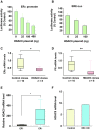Increased expression of the HDAC9 gene is associated with antiestrogen resistance of breast cancers
- PMID: 31099456
- PMCID: PMC6599838
- DOI: 10.1002/1878-0261.12505
Increased expression of the HDAC9 gene is associated with antiestrogen resistance of breast cancers
Abstract
Estrogens play a pivotal role in breast cancer etiology, and endocrine therapy remains the main first line treatment for estrogen receptor-alpha (ERα)-positive breast cancer. ER are transcription factors whose activity is finely regulated by various regulatory complexes, including histone deacetylases (HDACs). Here, we investigated the role of HDAC9 in ERα signaling and response to antiestrogens in breast cancer cells. Various Michigan Cancer Foundation-7 (MCF7) breast cancer cell lines that overexpress class IIa HDAC9 or that are resistant to the partial antiestrogen 4-hydroxy-tamoxifen (OHTam) were used to study phenotypic changes in response to ER ligands by using transcriptomic and gene set enrichment analyses. Kaplan-Meier survival analyses were performed using public transcriptomic datasets from human breast cancer biopsies. In MCF7 breast cancer cells, HDAC9 decreased ERα mRNA and protein expression and inhibited its transcriptional activity. Conversely, HDAC9 mRNA was strongly overexpressed in OHTam-resistant MCF7 cells and in ERα-negative breast tumor cell lines. Moreover, HDAC9-overexpressing cells were less sensitive to OHTam antiproliferative effects compared with parental MCF7 cells. Several genes (including MUC1, SMC3 and S100P) were similarly deregulated in OHTam-resistant and in HDAC9-overexpressing MCF7 cells. Finally, HDAC9 expression was positively associated with genes upregulated in endocrine therapy-resistant breast cancers and high HDAC9 levels were associated with worse prognosis in patients treated with OHTam. These results demonstrate the complex interactions of class IIa HDAC9 with ERα signaling in breast cancer cells and its effect on the response to hormone therapy.
Keywords: antiestrogen resistance; breast cancer; cell proliferation; estrogen receptor; histone deacetylase.
© 2019 The Authors. Published by FEBS Press and John Wiley & Sons Ltd.
Conflict of interest statement
The authors declare no conflict of interest.
Figures





References
-
- Augereau P, Badia E, Fuentes M, Rabenoelina F, Corniou M, Derocq D, Balaguer P and Cavailles V (2006) Transcriptional regulation of the human NRIP1/RIP140 gene by estrogen is modulated by dioxin signalling. Mol Pharmacol 69, 1338–1346. - PubMed
-
- Badia E, Duchesne MJ, Semlali A, Fuentes M, Giamarchi C, Richard‐Foy H, Nicolas JC and Pons M (2000) Long‐term hydroxytamoxifen treatment of an MCF‐7‐derived breast cancer cell line irreversibly inhibits the expression of estrogenic genes through chromatin remodeling. Cancer Res 60, 4130–4138. - PubMed
Publication types
MeSH terms
Substances
LinkOut - more resources
Full Text Sources
Medical
Research Materials
Miscellaneous

